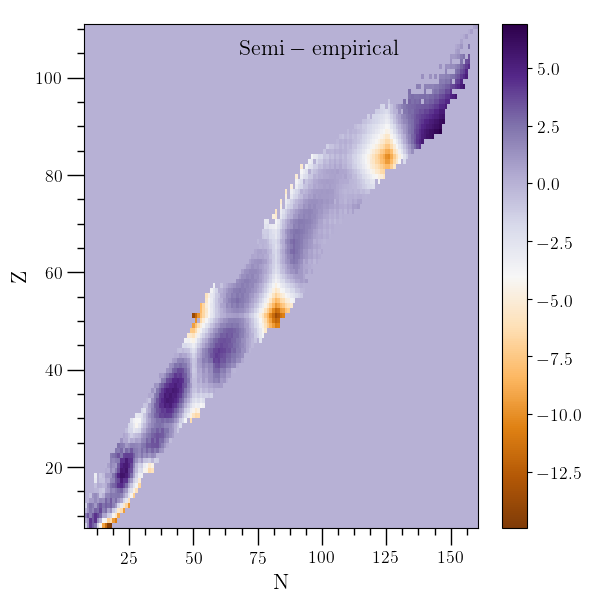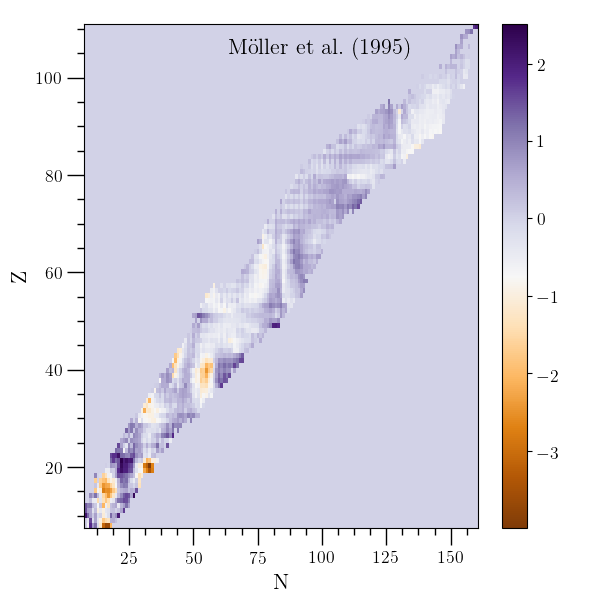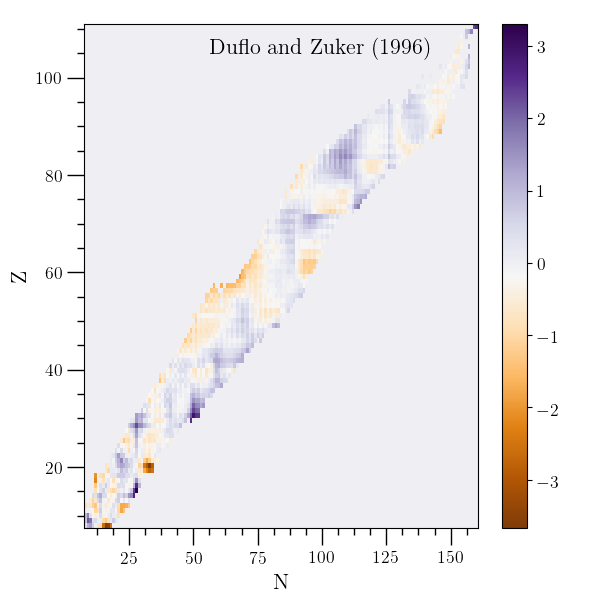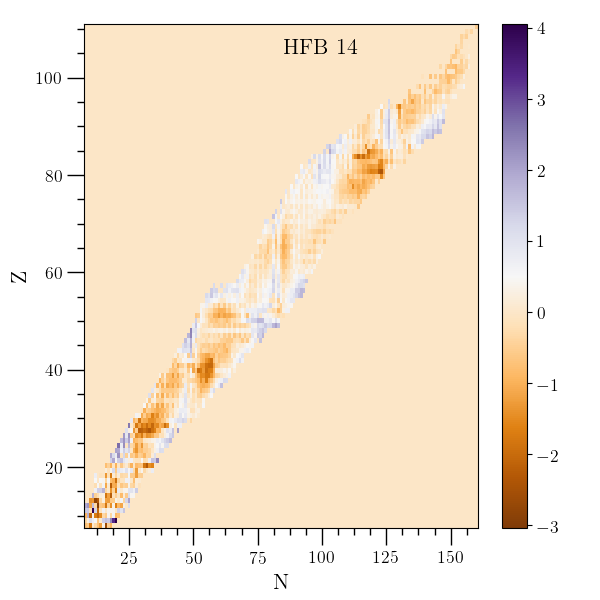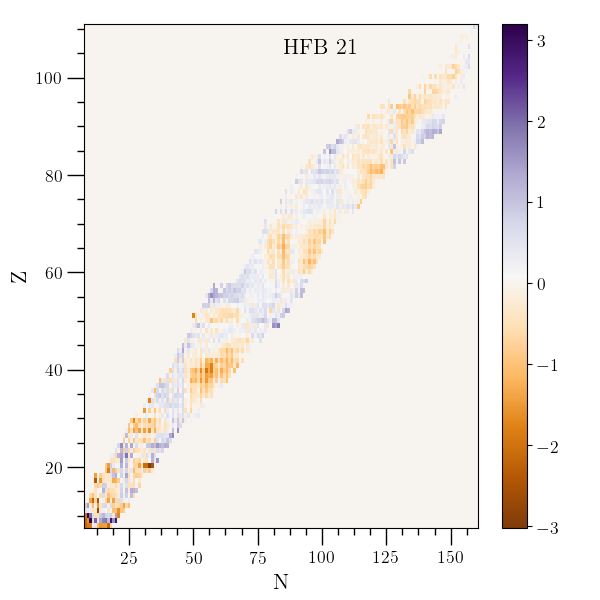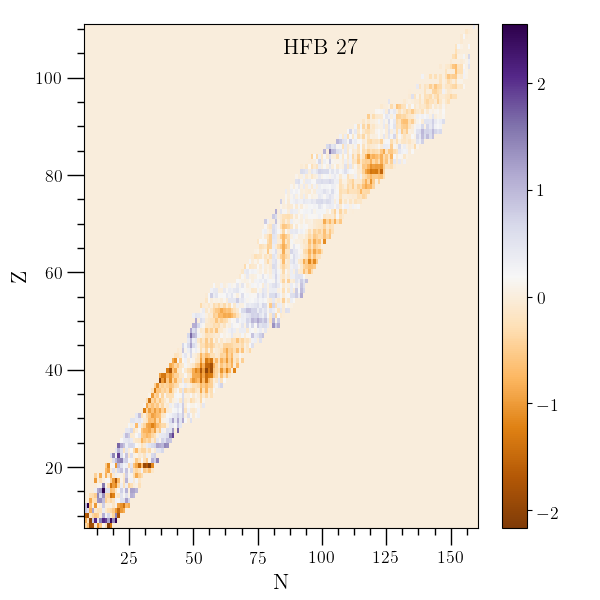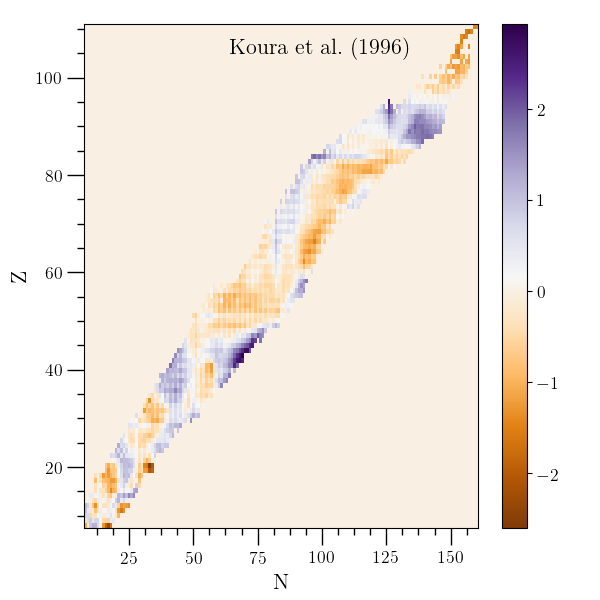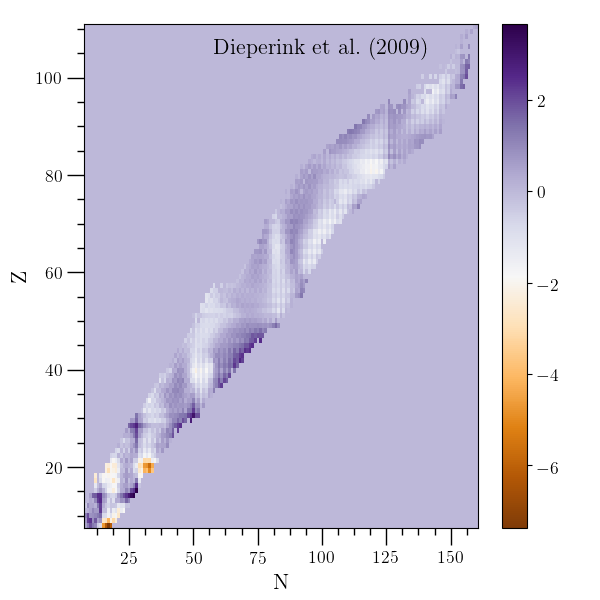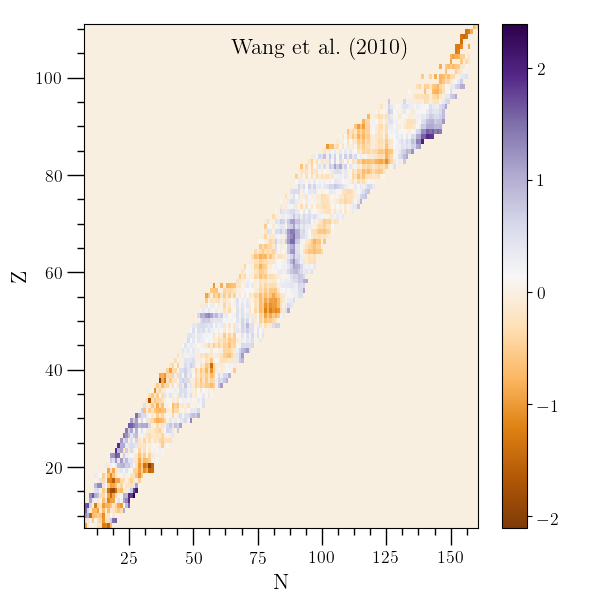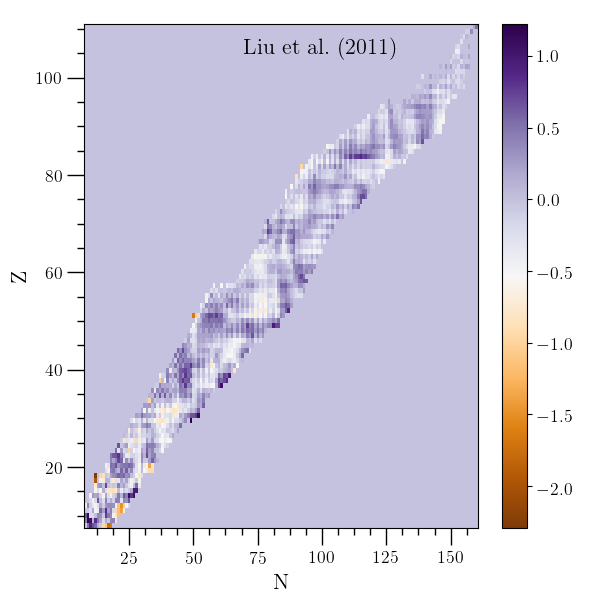Nuclei and Nuclear Masses¶
A basic data structure for nuclei, class o2scl::nucleus, is
implemented as a child of o2scl::part_tl.
Nuclear masses are given as children of o2scl::nucmass
and are generally of two types: tables of masses (children of
o2scl::nucmass_table) or formulas which generate masses
from a set of parameters and can be fit to data
(o2scl::nucmass_fit).
There are ten mass table types currently included.
o2scl::nucmass_ame: data from ref [Audi95], [Audi03], [Audi12] and [Wang12], [Huang17] and [Wang17], or [Huang21ta] and [Wang21ta].o2scl::nucmass_mnmskando2scl::nucmass_mnmsk_exp: masses from [Moller95], [Moller97], and [Moller16ng].o2scl::nucmass_hfbando2scl::nucmass_hfb_sp: masses from [Goriely02], [Samyn04], or [Goriely07].o2scl::nucmass_dz_table: masses from [Duflo95]o2scl::nucmass_ktuy: masses from [Koura00] and [Koura05]o2scl::nucmass_wlw: masses from [Wang10], [Wang10b], [Liu11], [Wang11], or [Wang14].o2scl::nucmass_sdnp: masses from [Stoitsov03] or [Dobaczewski04].o2scl::nucmass_dglg: masses from [Delaroche10].
The mass formulas which can be fit to data are
o2scl::nucmass_semi_empirical: simple 5 parameter semi-empirical methodo2scl::nucmass_frdm: macroscopic part of FRDM from [Moller95]o2scl::nucmass_dz_fitando2scl::nucmass_dz_fit_33: 10- and 33-parameter mass formulas from [Duflo95].o2scl::nucmass_dvi: 10-parameter formula from [Dieperink09] witho2scl::nucmass_ibm_shellfor shell effects
In order to create a set of nuclei stored in a std::vector
object, one can use o2scl_part::nucdist_set().
Nuclear mass fit example¶
/* Example: ex_nucmass_fit.cpp
-------------------------------------------------------------------
*/
#include <iostream>
#include <o2scl/test_mgr.h>
#include <o2scl/nucmass_fit.h>
#ifdef O2SCL_HDF
#include <o2scl/hdf_file.h>
#include <o2scl/hdf_nucmass_io.h>
#endif
using namespace std;
using namespace o2scl;
using namespace o2scl_const;
int main(void) {
test_mgr t;
t.set_output_level(1);
cout.setf(ios::scientific);
#ifdef O2SCL_HDF
// The RMS deviation of the fit
double res;
// The mass formula to be fitted
nucmass_semi_empirical sem;
// The fitting class
nucmass_fit mf;
// Load the experimental data
nucmass_ame ame;
o2scl_hdf::ame_load(ame,"12");
nucdist_set(mf.dist,ame);
// Perform the fit
mf.fit(sem,res);
// Output the results
cout << sem.B << " " << sem.Sv << " " << sem.Ss << " "
<< sem.Ec << " " << sem.Epair << endl;
cout << res << endl;
t.test_gen(res<4.0,"Successful fit.");
#else
cout << "No fitting was performed because O2scl appears not to have been "
<< "compiled with HDF support." << endl;
#endif
t.report();
return 0;
}
// End of example
Nuclear mass example¶
/* Example: ex_nucmass.cpp
-------------------------------------------------------------------
Demonstrate nuclear mass formulas by comparing them with
the Audi et al. (2012) atomic mass evaluation. This example
computes the absolute deviation in the mass excess.
*/
#include <iostream>
#include <o2scl/test_mgr.h>
#include <o2scl/table_units.h>
#include <o2scl/hdf_file.h>
#include <o2scl/hdf_io.h>
#include <o2scl/hdf_nucmass_io.h>
#include <o2scl/nucmass.h>
#include <o2scl/nucdist.h>
#include <o2scl/nucmass_fit.h>
#include <o2scl/nucmass_dz.h>
#include <o2scl/nucmass_hfb.h>
#include <o2scl/nucmass_wlw.h>
#include <o2scl/nucmass_ktuy.h>
using namespace std;
using namespace o2scl;
using namespace o2scl_const;
using namespace o2scl_hdf;
int main(void) {
cout.setf(ios::scientific);
test_mgr t;
t.set_output_level(2);
// ---------------------------------------------------------------
// The most recent experimental masses from the 2016 AME as a
// baseline. The flag 'true' at the end ensures only experimentally
// measured masses are included.
nucmass_ame ame;
o2scl_hdf::ame_load(ame,"16",true);
// ---------------------------------------------------------------
// Instantiate and load all of the nuclear mass objects. Some of
// them require a separate HDF5 file
nucmass_semi_empirical se;
nucmass_mnmsk mnmsk;
o2scl_hdf::mnmsk_load(mnmsk);
nucmass_hfb hfb14;
o2scl_hdf::hfb_load(hfb14,14);
nucmass_hfb_sp hfb21;
o2scl_hdf::hfb_sp_load(hfb21,21);
nucmass_hfb_sp hfb27;
o2scl_hdf::hfb_sp_load(hfb27,27);
nucmass_ame ame03;
o2scl_hdf::ame_load(ame03,"03",true);
nucmass_dz_table dz;
nucmass_ktuy ktuy05;
ktuy05.load("05");
nucmass_dvi dvi;
nucmass_wlw ws32;
ws32.load("WS3.2");
nucmass_wlw ws36;
ws36.load("WS3.6");
// ---------------------------------------------------------------
// List of pointers to all masses for convenience
static const size_t n_tables=11;
nucmass *massp[n_tables]={&se,&mnmsk,&hfb14,&hfb21,&hfb27,
&ame03,&dz,&ktuy05,&dvi,&ws32,&ws36};
// ------------------------------------------------------
// Create a list of all of the experimental masses
vector<nucleus> ame_dist;
nucdist_set(ame_dist,ame,"N>7 && Z>7");
// ------------------------------------------------------
// Fit the semi-empirical and DvI (2009) mass formulas to
// the 2012 AME data
static const size_t n_fits=2;
nucmass_fit mf;
// The default number of trials isn't enough for the DvI
// model, so we increase it
mf.def_mmin.ntrial*=10;
// Use the same list as above
mf.dist=ame_dist;
// The RMS deviation in the mass excess
double res;
// Fit both mass formulas
nucmass_fit_base *fitp[n_fits]={&se,&dvi};
for(size_t i=0;i<n_fits;i++) {
mf.fit(*(fitp[i]),res);
}
// ------------------------------------------------------
// Create a table to store the data
table_units<> tu;
tu.line_of_names(((string)"Z N ame se mnmsk hfb14 hfb21 ")+
"hfb27 ame03 dz96 ktuy05 dvi ws32 ws36");
// ------------------------------------------------------
// Fill the table
for(size_t i=0;i<ame_dist.size();i++) {
vector<double> line;
line.push_back(ame_dist[i].Z);
line.push_back(ame_dist[i].N);
double ame_mass=ame.mass_excess(ame_dist[i].Z,ame_dist[i].N);
line.push_back(ame_mass);
for(size_t j=0;j<n_tables;j++) {
if (massp[j]->is_included(ame_dist[i].Z,ame_dist[i].N)) {
double val=ame_mass-
massp[j]->mass_excess(ame_dist[i].Z,ame_dist[i].N);
line.push_back(val);
} else {
line.push_back(0.0);
}
}
tu.line_of_data(line);
}
// ------------------------------------------------------
// Output the table to a file
hdf_file hf;
hf.open_or_create("ex_nucmass_table.o2");
hdf_output(hf,tu,"nuclear_masses");
hf.close();
t.report();
return 0;
}
// End of example
|
|
|
|
|
|
|
|
|
|
|
